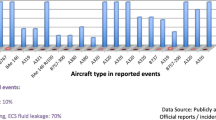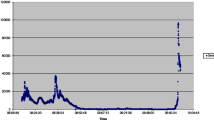Abstract
The cabin of an airplane is a specialised working environment and should be considered as such. The oils and hydraulics used in airplane engines are toxic, and specific ingredients of such materials are irritating, sensitising and neurotoxic. If oil or hydraulic fluids leak out of engines, this contamination may be in the form of unchanged oil/fluid, degraded oil/fluid from long use in the engine, combusted oil/fluid or pyrolised oil/fluid, in the form of gases, vapours, mists and particulate matter. If leak incidents occur and the oil/fluid is ingested into bleed air and is passed to the flight deck and passenger cabins of airplanes in flight, aircrew and passengers may be exposed to contaminants that can affect their health and safety. Where contamination of air in the flight deck and passenger cabin occurs that is sufficient to cause symptoms of discomfort, fatigue, irritation or toxicity, this contravenes the air quality provisions of Federal Aviation Regulations, most notably FAR 25.831. Symptoms of immediate or short-term nature and reported by exposed staff in single or few leak incidents are consistent with the development of irritation and discomfort. Symptoms of a long-term nature (that is, sustained symptoms for at least six months) reported by some exposed staff following small to moderate numbers of leak incidents are consistent with the development of an irreversible discrete occupational health condition, termed aerotoxic syndrome. Features of this syndrome are that it is associated with air crew exposure at altitude to atmospheric contaminants from engine oil or other aircraft fluids, temporarily juxtaposed by the development of a consistent symptomology including short-term skin, gastro-intestinal, respiratory and nervous system effects, and long-term central nervous and immunological effects.
Preview
Unable to display preview. Download preview PDF.
Similar content being viewed by others
Abbreviations
- CAS:
-
Chemical Abstracts Service
- COPIND:
-
Chronic organophosphate-induced neuropsychological disorder
- DOCP:
-
Di-ortho cresyl phosphate
- FAR:
-
U.S. Federal Aviation Regulation
- JAR:
-
Joint Aviation Regulation
- MOCP:
-
Mono-ortho cresyl phosphate
- MSDB:
-
Material Safety Data Bulletin
- NTE:
-
Neurotoxic esterases
- OHS:
-
Occupational Health and Safety
- OP:
-
Organophosphorus
- OPICN:
-
Organophosphorus ester-induced chronic neurotoxicity
- OPIDN:
-
Organophosphorus ester-induced delayed neurotoxicity
- PAN:
-
Phenyl-alpha naphthylamine
- TCP:
-
Tricresyl phosphate
- TOCP:
-
Tri-ortho cresyl phosphatekp
References
AMA CAT (1953) Aviation Toxicology: an Introduction to the Subject and a Handbook of Data. AeroMedical Association Committee of Aviation Toxicology, Blakiston, USA
Tupper CR (1989) Chemical hazards in aeromedical aircraft. Aviation, Space and Environmental Medicine 60:73–75
ASHRAE (1999) Air Quality Within Commercial Aircraft: ASHRAE Standard 161. American Society for Heating, Refrigeration, Airconditioning and Energy, Atlanta
Mattie DR, Hoeflich TJ, Jones CE, Horton ML, Whitmire RE, Godin CS, Femming CD, Andesen ME (1993) The comparative toxicity of operational air force hydraulic fluids. Toxicology and Industrial Health 9:995–1016
Hewstone RK (1994) Environmental health aspects of lubricant additives. Science of the Total Environment 156:243–254
Winder C, Balouet J-C (2002) Toxic ingredients in commercial jet fuels. Environmental Research 89:146–164
Balouet J-C, Kerguelen M, Winder C (2001) Toxicity and hypoxia: Hyperbaric pressure and LC50s for Carbon monoxide or Hydrogn cyanide. Toxicology 164:164
FAA (1965) Federal Air Regulations, Transport Category Airplanes, Airworthiness Standards, Section 25.831. US Federal Aviation Authority, Washington, DC
van Netten C (1998) Air quality and health effects associated with the operation of the BAe 146-200 aircraft. Applied Occupational and Environmental Hygiene 13:733–739
Balouet J-C, Winder C (1999) Aerotoxic syndrome in air crew as a result of exposure to airborne contaminants in aircraft. Paper presented at the American Society of Testing and Materials (ASTM) Symposium on Air Quality and Comfort in Airliner Cabins New Orleans, USA, 27–28 October
Winder C, Balouet J-C (2001) Symptoms of irritation and toxicity in aircrew as a result of exposure to airborne chemicals in aircraft. Journal of Occupational Health and Safety – Australian and New Zealand 17:471–483
BASI (1997) British Aerospace plc BAE 146-300 10 July 1997: Preliminary Report 9702276. Canberra: Bureau of Air Safety Inspection, 23 October 1997
Buck WH (1999) Mobil Oil Corporation. Correspondence, 27 July 1999
CAT, AMA (1953) Aviation Toxicology: An Introduction to the Subject and a Handbook of Data. Committee of Aviation Toxicology, Aero Medical Association, Blakiston, USA
Tupper CR (1989) Chemical hazards in aeromedical aircraft. Aviation, Space and Environmental Medicine 60:73–75
Smith PW, Lacefield DJ, Crane CR (1970) Toxicological findings in aircraft accident investigation. Aerospace Medicine 41:760–762
Trimble EJ (1996) The management of aircraft passenger survival in fire. Toxicology 115:41–61
Mackerer CR, Barth ML, Krueger AJ, Chawla B, Roy TA (1999) Comparison of neurotoxic effects from oral administration or ingestion of tricresyl phosphate and jet engine oil containing tricresyl phosphate. J Toxicology and Environmental Health 57:293–328
ACC (2001) High Production Volume Chemical Submission, Substituted Diphenylamines. American Chemistry Council, Arlington VA, 18 December 2001. At: http://www.epa.gov.gov/chemrtk/subdiapha/c13378.pdf
Miyazaki K, Kawai S, Sasayama T, Iseki K, Arita T (1987) Absorption, metabolism and excretion of N-phenyl-1-naphthylamine in rats. Yakuzaigaku. Archives of Practical Pharmacology 47:17–22 (English abstract)
IPCS (1998) Concise International Chemical Assessment Document No 9: N-Phenyl-1-naphthylamine. International Programme on Chemical Safety, Geneva
Boman A, Hagelthorn G, Jeansson I, Karlberg A-T, Rystedt I, Wahlberg JE (1980) Phenyl-alpha-naphthylamine–case report and guinea pig studies. Contact Dermatitis 6:299–300
Kalimo K, Jolanki R, Estlander T, Kanerva L (1989) Contact allergy to antioxidants in industrial greases. Contact Dermatitis 20:151–152
Carmichael AJ, Foulds IS (1990) Isolated naphthylamine allergy to phenyl-alpha-napthylamine. Contact Dermatitis 22:298–299
Wang H-W, Wang D, Dzeng R-W (1984) Carcinogenicity of n-phenyl-1-naphthylamine and n-phenyl-2-naphthylamine in mice. Cancer Research 44:3098–3100
Jarvholm B, Lavenius B (1981) A cohort study on cancer among workers exposed to an antirust oil. Scandinavian J Work Environment and Health 7:179–184
US NTP (1988) Toxicology and Carcinogenesis Studies of N-Phenyl-2-naphthylamine in F344/N Rats and B6C3F1 Mice (feed studies). US National Toxicology Program, http://ntp-server.niehs.nih.gov/htdocs/lt-studies/tr333.html
Echobion DJ (1993) Organophosphorus ester insecticides. In: Echobion DJ, Joy RM (eds) Pesticides and Neurological Diseases, second edition. CRC Press, Boca Raton
Aldridge WN (1954) Tricresyl phosphate and cholinesterase. Biochemical J 56:185–189
Johnson MK (1975) Structure activity relationship for substrates and inhibitors of hen brain neurotoxic esterase. Biochemical Pharmacology 24:797–805
Earl CJ, Thompson RHS (1952) Cholinesterase levels in the nervous system in tri-ortho-cresyl phosphate poisoning. British J Pharmacology 7:685–694
Eyer P (1955) Neuropsychopathological changes by organophosphorus compounds–a review. Human and Experimental Toxicology 14:857–864
Kilburn KH (1999) Evidence for chronic neurobehavioral impairment from chlorpyrifos and organophosphate insecticide (Dursban) used indoors. Environmental Epidemiology and Toxicology 1:153–162
Minton NA, Murray VSG (1988) A review of organophosphate poisoning. Medical Toxicology 3:350–375
Johnson MK (1975) Organophosphorus esters causing delayed neurotoxic effects. Archives of Toxicology 34:259–288
Metcalf RL (1982) Historical perspective of organophosphorus ester-induced delayed neurotoxicity. Neurotoxicology 3:269–284
Baron RL (1981) Delayed neurotoxicity and other consequences of organophosphate esters. Annual Reviews of Entolomology 26:29–48
Johnson MK (1990) Organophosphates and delayed neuropathy–Is NTE alive and well? Toxicology and Applied Pharmacology 102:385–399
Senanayake N, Karalliede L (1987) Neurotoxic effects of organophosphorus esters. An intermediate syndrome. New England J Medicine 316:761–763
Dille JR, Smith PW (1964) Central nervous system effects of chronic exposure to organophosphate insecticides. Aerospace Medicine 35:475–478
Savage EP, Keefe TF, Mounce LM, Heaton JA, Burcar PJ (1988) Chronic neurological sequelae of acute organophosphorus pesticide intoxication. Archives of Environmental Health 43:38–45
Rosenstock L, Keifer M, Daniell WE, McConnell R, Claypoole K (1991) Chronic central nervous system effects of acute organophosphate pesticide intoxication. Lancet 338:225–227
Steenland M (1996) Chronic neurological effects of organophosphate pesticides. British Medical J 312:1311–1312
UK DoH (1999) Toxicology of OPs and the mechanisms involved. In: Organophosphates. Committee on Toxicity of Chemicals in Food, Consumer Products and the Environment, Chap. 5. UK Department of Health, HMSO, London, pp 49–58
Jamal GA (1997) Neurological syndromes of organophosphorus compounds. Adverse Drug Reactions and Toxicology Reviews 16:133–170
Savage EP, Keefe TF, Mounce LM, Heaton JA, Burcar PJ (1988) Chronic neurological sequelae of acute organophosphorus pesticide intoxication. Archives of Environmental Health 43:38–45
Gershon S, Shaw FB (1961) Psychiatric sequelae of chronic exposure to organophosphorous insecticides. Lancet 1:1371–1374
Metcalf DR, Holmes JH (1969) EEG, psychological and neurological alterations in humans with organophosphorous exposure. Annals New York Academy Science 160:357–365
Callender TJ, Morrow L, Subramanian K (1994) Evaluation of chronic neurological sequelae after acute pesticide exposure using SPECT brain scans. J Toxicology and Environmental Health 41:275–284
Abou-Donia MB (2004) Organophosphorus ester-induced chronic neurotoxicity. Archives of Environmental Health 58:484–497
Smith MI, Elvove I, Valaer PJ, Frazier WH, Mallory GE (1930) Pharmacologic and chemical studies of the cause of the so called ginger paralysis. US Public Health Reports 45:1703–1716
Henschler D, Bayer HH (1958) Toxicologic studies of triphenyl phosphate, trixenyl phosphates, and triaryl phosphates from mixtures of homogenous phenols. Archives of Experimental Pathology and Pharmacology 233:512–517
Henschler D (1958) Die Trikresylphosphatvergiftung. Experimentelle Klärung von Problemen der Ätiologie und Pathogenese (Tricresyl phosphate poisoning. Experimental clarification of problems of etiology and pathogenesis). Klinische Wochenschriften 36:663–674
Daughtrey W, Biles R, Jortner B, Erlich M (1996) Subchronic delayed neurotoxicity evaluation of jet engine lubricants containing phosphorus additives. Fundamental and Applied Toxicology 32:244–249
Montgomery MR, Wier GT, Zieve FJ, Anders MW (1977) Human intoxication following inhalation exposure to synthetic jet lubricating oil. Clinical Toxicology 11:423–426
Rayman RB, McNaughton GB (1983) Smoke/fumes in the cockpit. Aviation, Space and Environmental Medicine 67:738–740
Tashkin DP, Coulson AH, Simmons MS, Spivey GH (1983) Respiratory symptoms of flight attendants during high altitude flight: Possible relation to cabin ozone exposure. Archives of Occupational and Environmental Health 52:117–137
Sparks PS, Simon GE, Katon WJ, Altman LC, Ayars GH, Johnson RL (1990) An outbreak of illness among aerospace workers. Western J Medicine 158:28–33
Winder C, Fonteyn P, Balouet J-C (2002) Aerotoxic syndrome: A descriptive epidemiological survey of aircrew exposed to in-cabin airborne contaminants. J Occupational Health and Safety – Australia and New Zealand 18:321–338
Cox L, Michaelis S (2002) A survey of health symptoms in BAe 146 aircrew. J Occupational Health and Safety – Australia and New Zealand 18:305–312
Michaelis S (2003) A survey of health symptoms in BALPA Boeing 757 pilots. J Occupational Health and Safety – Australia and New Zealand 19:253–261
NAS (2001) The Airliner Cabin Environment and the Health of Passengers and Crew. US National Academy of Science, National Academy Press, Washington, DC
Singh B (2004) In flight smoke and fumes. Aviation Safety Spotlight, March 2004
Fox R (1997) Air Quality Testing Aboard Ansett Airlines BAe 146 Aircraft: Final Report. Allied Signal Aerospace, 25 November 1997
Craig P, Barth M (1999) Evaluation of the hazards of industrial exposure to tricresyl phosphate: A review and interpretation of the literature. J Toxicology and Environmental Health Part B Critical Reviews 2:281–300. Consultants, Mobil Business resources Coorporation, NJ
WHO (1986) Diseases caused by asphyxiants: Carbon monoxide, Hydrogen cyanide and its toxic derivatives, and Hydrogen sulfide. Early Detection of Occupational Diseases. World Health Organization, Geneva, pp 154–164
Fox RB (2000) Air quality and comfort measurement aboard a commuter aircraft and solutions to improve perceived occupant comfort levels. In: Nagda NL (ed) Air quality and comfort in airliner cabins. ASTM STP 1393. American Society for Testing and Materials, West Conshohocken, PA
Michaels D (2005) Doubt is their product. Scientific American, June 2005
Author information
Authors and Affiliations
Corresponding author
Editor information
Rights and permissions
About this chapter
Cite this chapter
Winder, C., Michaelis, S. Crew Effects from Toxic Exposures on Aircraft. In: Hocking, M. (eds) Air Quality in Airplane Cabins and Similar Enclosed Spaces. The Handbook of Environmental Chemistry, vol 4H. Springer, Berlin, Heidelberg. https://doi.org/10.1007/b107246
Download citation
DOI: https://doi.org/10.1007/b107246
Published:
Publisher Name: Springer, Berlin, Heidelberg
Print ISBN: 978-3-540-25019-7
Online ISBN: 978-3-540-31491-2
eBook Packages: Earth and Environmental ScienceEarth and Environmental Science (R0)




